#dicksoniaceae
Text
#1906 - Dicksonia squarrosa - New Zealand Tree Fern
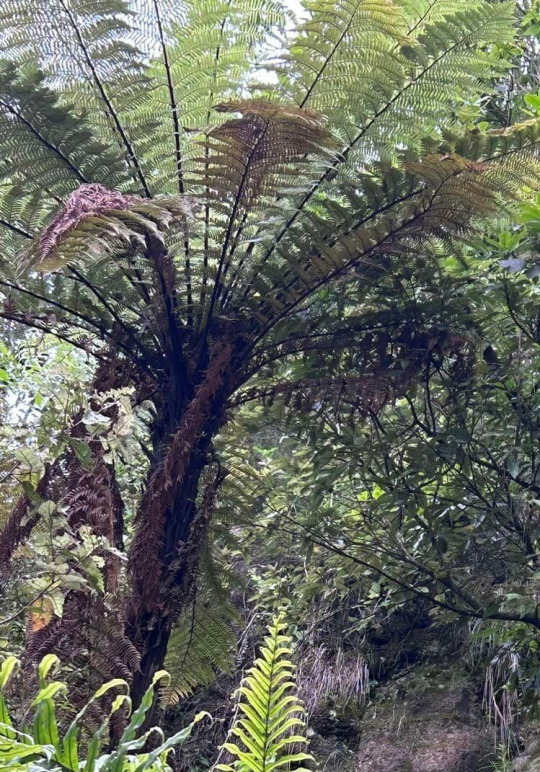
AKA wheki, rough tree fern, harsh tree fern, Trichomanes squarrosum, Dicksonia gracilis, Dicksonia squarrosa var. gracilis, and Balantium squarrosum. Not to be confused with Dicksonia antarctica, the Soft Tree Fern
Another of Aoteoroa’s large ferns - these tree ferns grow up to 7m tall, connected to each other by rhizomes, forming groves. This one was near Huka Falls like some of the previous ones, but it’s found over much of New Zealand and some nearby islands, in coastal to montane forest on the North Island, but on the South Island it is largely confined to coastal and lowland sites.
A rapidly growing tree fern, that can do surprisingly well in a container or small garden as long as it doesn’t get too much exposure to harsh sun or very cold weather. Earned the Royal Horticultural Society's Award of Garden Merit, but I’m not sure which year.
The Māori used to build fences for their fortified Pā from dead whekī trunks
7 notes
·
View notes
Text

Dicksonia antarctica
20-JAN-2023
Melbourne, Vic
#australia#victoria#melbourne#australian natives#native flora#fern#tree fern#soft tree fern#man fern#tracheophytes#polypodiophyta#polypodiopsida#cyatheales#dicksoniaceae#dicksonia#dicksonia antarctica#fern frond
0 notes
Text
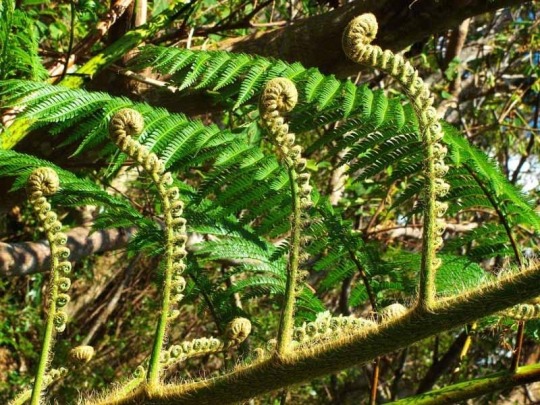


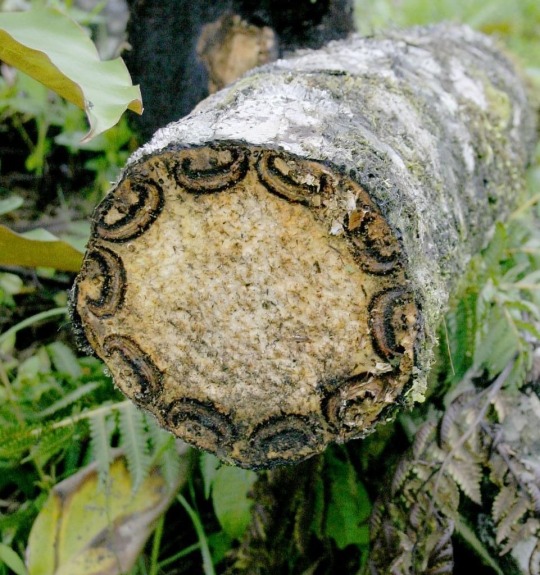
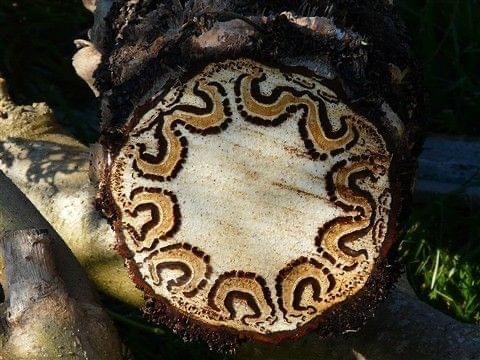


The Flying Spider-monkey Tree Fern 🌿
Sphaeropteris lepifera, synonym Cyathea lepifera, the brush pot tree, is a tree fern that grows in the mountains of East and Southeast Asia, which can grow up to 20 feet tall. The plant has existed for over 300 million years and is considered a living fossil. Wikipedia
Class: Polypodiopsida
Kingdom: Plantae
The tree ferns are the ferns that grow with a trunk elevating the fronds above ground level. Most tree ferns are members of the "core tree ferns",
belonging to the families Dicksoniaceae, Metaxyaceae, and Cibotiaceae in the order Cyatheales.
Wiki: https://en.wikipedia.org/wiki/Sphaeropteris_lepifera
3K notes
·
View notes
Photo
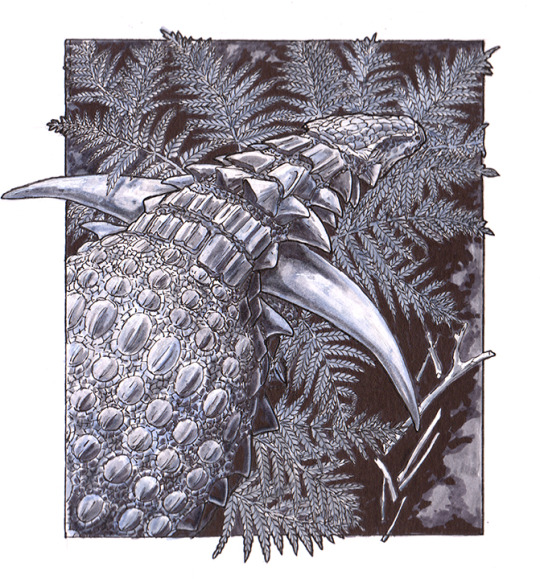
I'm going a bit slower than I would like, mostly because I'm focusing on quality over quantity, but also because I'm this one was really detailed and just took a while. Anyway, since the second prompt was Dicksoniaceae (ferns) I chose to reproduce an animal we know may have eaten them taking a nap in them instead, Borealopelta.
#borealopelta#dinaptober#dinoctober#naptober#dinosaur#dinosaurart#dino#dinoart#paleo#paleoart#sciart#science#drawingchallenge#artchallenge#artistsontumblr
294 notes
·
View notes
Photo

Dicksoniaceae
6 notes
·
View notes
Text
Day 2. Dicksoniaceae
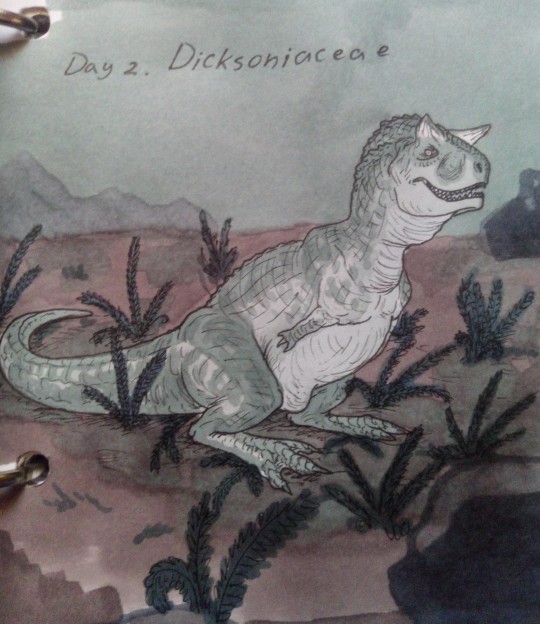
6 notes
·
View notes
Text
26 October - 13 November 2020
These past few weeks have been an emotional roller-coaster. Back in September several friends, within 48 hours of each other, informed me about an amazing opportunity in the south of France. I was so touched that people were looking out for me, knowing I’ve been aching to move to somewhere warmer, more Mediterranean. I hesitated for a week because the job announcement on a garden designer’s Facebook page stated French was important. I’ve studied French for a long time and I still have a long way to go to fluency. Again, later in the week, another friend from Kew mentioned it and knew the garden personally.
So I took the plunge and sent my CV, in French, to the garden designers. They liked it well enough to pass it to the client. A week later I had my first phone interview and it went well. Now I was super excited and could hardly sleep. On paper this job sounds really good. I checked out some You Tube videos on the garden designer, their preferred maintenance contractor and the nursery they use. I only became more interested and excited.
Plant ident 30 October
Lamiaceae Salvia africana-lutea syn. of Salvia aurea
Lamiaceae Salvia canariensis
Lamiaceae Salvia confertiflora
Lamiaceae Salvia elegans ‘Honey Melon’
Lamiaceae Salvia greggii x serpyllifolia
Lamiaceae Salvia greggii ‘Stormy Pink’
Lamiaceae Salvia involucrata
Lamiaceae Salvia microphylla var. neurepia ‘Oxford’
Lamiaceae Salvia ‘Nel’
Lamiaceae Salvia ‘Phyllis Fancy’
Plant of the week
Lamiaceae Salvia confertiflora Pohl
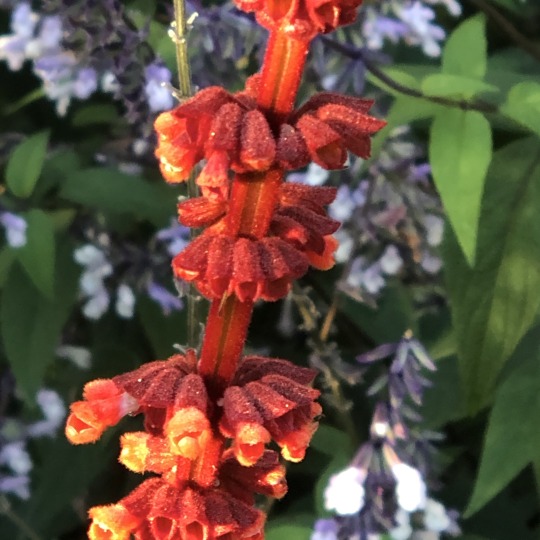
common name(s) - Sabra spike sage
synonym(s) - Salvia confertiflora var. angustifolia J.A.Schmidt; Salvia confertiflora var. brachyantha Pohl; Salvia rufa Epling
conservation rating - none
native to - Brazil
location - salvia walk, accession 2019-0398
leaves - deciduous, pungently-scented, ovate
flowers - slender spikes of small scarlet flowers, covered with velvety red-brown hairs, with the stems of the inflorescence and the calyx also having a red-brown colour, in late summer and autumn
habit - a tender bushy perennial to 1.2m tall, becoming woody at the base
habitat - tropical, summer rains, dry winters
pests - slugs, snails, capsid bug, rosemary beetle, leafhoppers
disease - generally disease-free
hardiness - to 1ºC (H2)
soil - loam, chalk or sand, well-drained
sun - full sun, sheltered
propagation - seed in containers in a cold frame in spring; softwood cuttings in spring or early summer or semi-ripe cuttings in late summer or autumn with bottom heat
pruning - cut down if hit by frost
nomenclature - Lamiaceae - lamium - gullet, the name in Pliny refers to the gaping mouth of the corolla; Salvia - healer, the old Latin name for sage with medicinal properties; confertiflora - with dense or crowded flowers
NB - first discovered in 1833 by the Austrian naturalist, Johann Baptist Emanuel Pohl in the Serra dos Órgãos, state of Rio de Janeiro. Pohl sent specimens back to botanical gardens of Europe where it was popular not only for its dramatic colour, but also for its prolific flowering well up to the time of frost
References, bibliography:
Gledhill, David, (2008) “The Names of Plants”, fourth edition; Cambridge University Press; ISBN: 978-0-52168-553-5
IUCN [online] http://www.iucnredlist.org/search [18 Nov 20]
Plant List, The [online] http://www.theplantlist.org/tpl1.1/record/kew-182420 [18 Nov 20]
Plants of the World [online] http://plantsoftheworldonline.org/taxon/urn:lsid:ipni.org:names:456011-1 [18 Nov 20]
Royal Horticultural Society [online] https://www.rhs.org.uk/Plants/16324/i-Salvia-confertiflora-i/Details [18 Nov 20]
Wikipedia [online] https://en.wikipedia.org/wiki/Salvia_confertiflora [18 Nov 20]
About ten days later I received an email inviting me to meet with his wife, here in London, for a second interview. That took place one evening after work. Again, the conversation went very well and it turns out we have a friend in common - who would have imagined!
The following week, after posting some tea to my sister in LA, I received the call offering me the position. Again, no sleep that night!
While all of this was happening, my tinnitus has been acting up too. I have also experienced a few bouts of vertigo, which is quite rare for me.
So that Friday, two weeks ago, I tendered my resignation. I asked to take my remaining annual leave as part of my notice period which meant I only had two weeks left in the garden. This will give me next week to sort my packing and I’ll fly to Nice next Saturday, 21 November. This will give me one week to work with the person who is leaving. I’ve never had such a fantastic opportunity for a week-long hand-over.
Plant ident 6 November this week was a review of the past four weeks, those were my favourites at Kew because it helped me retain names that would otherwise have just never stuck.
Plant of the week
Cucurbitaceae Momordica charantia L.

common name(s) - bitter melon; bitter apple; bitter gourd; bitter squash; balsam-pear
synonym(s) - Cucumis argyi H.Lév.; Cucumis intermedius M.Roem.; Momordica charantia subsp. abbreviata (Ser.) Greb.; Momordica charantia f. abbreviata (Ser.) W.J.de Wilde & Duyfjes; Momordica charantia var. abbreviata Ser.; Momordica charantia var. longirostrata Cogn.; Momordica charantia var. muricata (Willd.) Chakrav.; Momordica chinensis Spreng.; Momordica elegans Salisb.; Momordica indica L.; Momordica muricata Willd.; Momordica sinensis Spreng.; Momordica thollonii Cogn.; Sicyos fauriei H. Lév.
conservation rating - none
native to - tropical and subtropical Old World
location - tropical corridor, accession 2020-0110
leaves - simple, alternate leaves 40 to 120mm across, with three to seven deeply separated lobes
flowers - separate yellow male and female flowers; in the Northern Hemisphere, flowering occurs during June to July and fruiting during September to November
habit - very vigorous, tendril-bearing vine to 5m
habitat - hot humid areas of the tropics and subtropics; savannah and bush; common in coastal thickets, along creeks and streams, and in lowland forest margins
pests - aphids
disease - downy mildew, powdery mildew, Fusarium wilt, target leaf spot, root-knot
hardiness - to 5ºC (H1c)
soil - rich in organic matter with 2m to 2.5m of rainfall annually
sun - full sun
propagation - seed - sow in situ; seedlings emerge five to seven days after sowing, but fresh seed often shows dormancy which is very hard to break and can last for some months
pruning - none
nomenclature - Cucurbitaceae - cucurbita - Latin name for the bottle-gourd; Momordica - bitten, the jagged seeds of balsam pear appear to have been nibbled; charantia - graceful, the pendent fruits
NB - is a laxative, diuretic herb that soothes irritated tissue, lowers fevers, kills parasites and cleanses toxins from the system; probably also a uterine stimulant; the fruit is most often eaten green, or as it is beginning to turn yellow. At this stage, the fruit's flesh is crunchy and watery in texture, similar to cucumber, chayote or green bell pepper, but bitter. The skin is tender and edible.
References, bibliography:
Gledhill, David, (2008) “The Names of Plants”, fourth edition; Cambridge University Press; ISBN: 978-0-52168-553-5
IUCN [online] http://www.iucnredlist.org/search [20 Nov 20]
Plant List, The [online] http://www.theplantlist.org/tpl1.1/record/kew-2372864 [20 Nov 20]
Plants of the World [online] http://plantsoftheworldonline.org/taxon/urn:lsid:ipni.org:names:293413-1 [20 Nov 20]
Useful Tropical Plants [online] http://tropical.theferns.info/viewtropical.php?id=Momordica+charantia [20 Nov 20]
Wikipedia [online] https://en.wikipedia.org/wiki/Momordica_charantia [20 Nov 20]
I worked the weekend of 7/8 November, my last weekend duty.
I’ve been taking private French lessons twice a week for the past three weeks. François has been taking an hour out every weekend to help me with my French. I’m hoping once I start living in the language it will come together. Lucien organised my French mobile number, so it will be ready to use when I land.
During these few weeks in the garden leaves have been falling and falling and falling. Al spends most mornings blowing leaves into big piles. He’s also agreed to stay on through the end of January.
Plant ident 13 November ferns
Aspleniaceae Asplenium trichomanes
Aspleniaceae Asplenium scolopendrium
Blechnaceae Blechnum cordatum
Dennstaedtiaceae Pteridium aquilinum
Dicksoniaceae Balantium antarcticum syn. Dicksonia antarctica
Dryopteridaceae Polystichum setiferum
Polypodiaceae Adiantum venustum
Polypodiaceae Microsorum diversifolium syn. Phymatosorus pustulatus subsp. pustulatus
Polypodiaceae Polypodium interjectum
Pteridaceae Coniogramme emeiensis
I gave Olivia a thorough hand-over of my beloved tropical glasshouse. I’m sure it is in good hands, and under the always watchful eye of Jess.

Jess and I gave the tropical corridor it’s winter pruning on Thursday.
Nell has allowed me to work on several projects on the database I’ve been trying to complete. I added to my predecessor’s manual for the plant records manager. It is quite comprehensive. I hope my replacement finds it helpful and continues to update it as the roll changes.
Wednesday, when Jill was in the garden, I asked her to create a herbarium specimen of the Romneya coulteri for me, also being a California native.
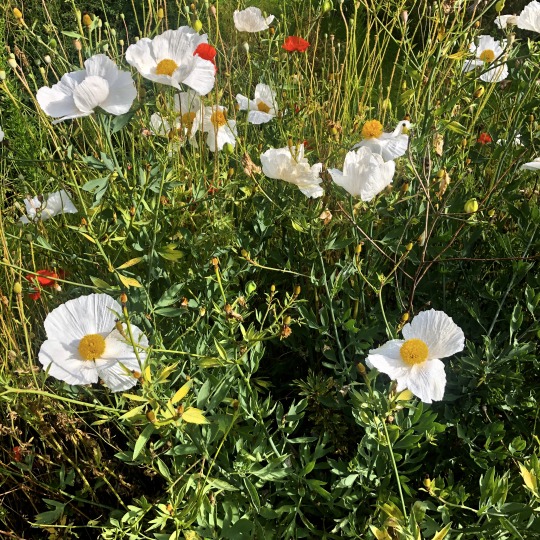
Friday, 13 November, saying goodbye... I made my way to Victoria in the morning, before work, to purchase one last social from Ole & Steen. After work we indulged in cheese, beers and Nell gave a very nice speech.
Mary Ellen painted this for me, and the plant and secateurs were gifts from colleagues.

The evening concluded with a stint in the jacuzzi - so very relaxing.

Plant of the week - a foreshadow of the next garden in which I shall be working
Cistaceae Cistus creticus L.
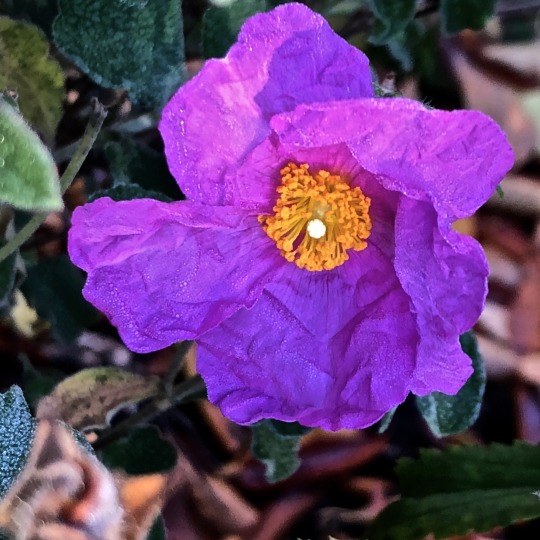
common name(s) - Cretan rockrose
synonym(s) - Cistus complicatus Spruner ex Nyman; C. creticus f. albus (O.E.Warb.) Demoly; C. creticus f. flavus Demoly; C. creticus subsp. trabutii (Maire) Dobignard; C. cupanianus C.Presl; C. dunalianus Sweet; C. garganicus Ten.; C. × incanus subsp. creticus (L.) Heywood; C. incanus subsp. creticus (L.) Heyw.; C. ladaniferus Stokes; C. polymorphus Willk.; C. rotundifolius Sweet; C. tomentosus Lam. [Illegitimate]; C. undulatus Moench; C. villosus L.; C. villosus f. albus O.E.Warb.; C. villosus var. creticus (L.) Boiss.; C. villosus var. rotundifolius (Sweet) Grosser; C. villosus var. trabutii Maire; C. villosus var. undulatus Grosser; C. vulgaris Spach; Ladanium officinarum Spach; Ladanum verum Raf.
infraspecific taxa - Cistus creticus subsp. corsicus (Loisel.) Greuter & Burdet; Cistus creticus subsp. eriocephalus (Viv.) Greuter & Burdet
conservation rating - none
native to - central and eastern European Mediterranean to Jordan
location - history beds, accession 1996-0376
leaves - shaggily hairy stems, leaves are slightly scented
flowers - variable in shade from deep purple-pink to rose pink, to 6cm across, with a yellow centre
habit - very variable, small, bushy, evergreen shrub, to perhaps 1.5m tall; highly branched shrub that measures between 30 to 140 cm with a more or less creeping stem but without actually taking root in the ground, with little strength to stay upright
habitat - distributed in calcareous romerales that inhabit soils with sandy characteristics; can be found growing near oak forests on the coast
pests - generally pest-free
disease - may suffer from nutrient deficiency when grown on very alkaline soils
hardiness - to -10ºC (H4)
soil -well-drained
sun - full sun, sheltered
propagation - seed, sow as soon as ripe and keep in cold frame or sow in spring; softwood cuttings in summer
pruning - does not respond well to hard renovation pruning
nomenclature - Cistaceae - Cistus - capsule, rock roses are conspicuous in fruit; creticus - from Crete, Cretan
NB - traditional herbal medicine, the leaves of Cistus have been used in the treatment of skin and inflammatory diseases (Hudson, 2009). Recent scientific research has confirmed the validity of this traditional herbal knowledge through studies that have demonstrated that Cistus leaf extractives have powerful antibacterial, antifungal, antiviral, and biofilm-breaking qualities (Rebensburg et al, 2015).
References, bibliography:
Gledhill, David, (2008) “The Names of Plants”, fourth edition; Cambridge University Press; ISBN: 978-0-52168-553-5
IUCN [online] http://www.iucnredlist.org/search [19 Nov 20]
Plant List, The [online] http://www.theplantlist.org/tpl1.1/record/kew-2723343 [19 Nov 20]
Plants of the World [online] http://plantsoftheworldonline.org/taxon/urn:lsid:ipni.org:names:168230-1 [19 Nov 20]
ProHealth [online] https://www.prohealth.com/library/cistus-a-natural-antibiotic-antiviral-and-biofilm-buster-6292 [19 Nov 20]
Royal Horticultural Society [online] https://www.rhs.org.uk/Plants/22292/Cistus-creticus/Details [19 Nov 20]
Warbleton Council [online] https://warbletoncouncil.org/cistus-creticus-13547 [19 Nov 20]
SARS-CoVid-2 update (active cases only) 2 November 2020

SARS-CoVid-2 update (active cases only) 8 November 2020

SARS-CoVid-2 update (active cases only) 16 November 2020

0 notes
Text
Cây cẩu tích - Tác dụng, công dụng và bài thuốc chữa bệnh

Hình ảnh cây cẩu tích
1. Cây cẩu tích (lông cu li) là gì?
Cây cẩu tích có tên khoa học là Cibotium barometz (L.) J.Smith thuộc họ Lông Cu li hay họ Dương xỉ (Dicksoniaceae).
Nó còn có tên gọi khác là Kim mao cẩu tích, Cu li, Rễ lông Cu li, Cù liền.
1.1. Đặc điểm của cây cẩu tích
Cẩu tích là một loại quyết thực vật hay dương xỉ, cây mọc thẳng cũng chỉ cao tới 1m, nhưng nó thường mọc bò trên các sườn đồi tại các khu rừng thưa và khu vực có dấu chân người.
Thân rễ mọc thẳng và được bao phủ bởi những sợi lông vàng cứng.
Lá mọc thành chùm ở đỉnh của thân cây, cuống lá to, đường kính 2cm, dài hơn 1,5m; có màu nâu; phần gốc lá có lông, phần còn lại có hình nón khi còn non, màu sáng khi già.
Lá có mặt trên màu xanh lục sẫm, mặt dưới màu nhạt hơn; ở mặt dưới có các lông màu nhạt, chằng chịt, mềm, mềm, có lông tơ (cây non có lông trong suốt).
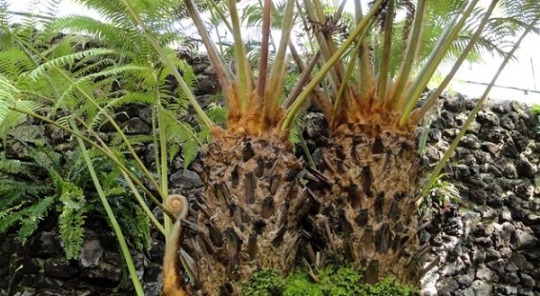
Đặc điểm của cây cẩu tích
Ổ túi bào tử của cây như hai môi úp vào nhau, túi áo có 2 van. Ổ túi nằm ở mép lá, có màu nâu và hai môi không đều nhau, cái ở ngoài hình cầu, cái ở trong hẹp và hơi thuôn, ổ túi nằm ẩn sâu phía bên trong.
Túi bào tử có vòng cơ giới đầy đủ, hơi nghiêng và có xu hướng mở theo đường bên. Túi bào tử nằm ở mặt dưới của lá cây và chứa các bào tử. Bào tử có hình hơi tròn hoặc hình tam giác, sần sùi, màu hơi xám hoặc sáng, có cánh.
Bài nên xem
Trị Cốt Tán có tốt không? Mọi người nói gì về Trị Cốt Tán?
1.2. Phân bố
Cây cẩu tích thường mọc trên đồi hoặc bờ suối trong rừng thường xanh nhiệt đới ở độ cao 500 - 800m và trong rừng núi thấp ở độ cao 1000 - 1600m, nơi không có đá vôi.
Ở Việt Nam, cây phân bố rải rác ở các vùng miền núi phía Tây Bắc như Lào Cai, Lại Châu, Sơn La, Điện Biên, Hòa Bình,... hoặc các tỉnh miền Trung từ Quảng Nam đến Đà Nẵng; Lâm Đồng.
1.3. Bộ phận dùng
Bộ phận dùng của cây là phần thân rễ được dùng để làm thuốc.
1.4. Thu hái, sơ chế và bảo quản
Thu hái
Cây thu hái quanh năm nhưng để dược liệu đạt được hàm lượng dược chất nhiều nhất thì nên thu hoạch vào mùa thu - đông.
Sơ chế
Khi thu hái, người dân thường chặt bỏ toàn bộ cành, lấy phần bẹ và những vùng lông vàng của cây bao phủ.
Cây đào từ rừng đem về được cắt bỏ phần rễ (chỉ lấy phần củ và lông vàng) và đem thái miếng phơi khô.
Có khi đồ hơi nước hoặc đồ với đậu đen 9 lần đồ, 9 lần phơi rồi đem thái mỏng, phơi khô.
Nếu không lấy phần lông thì có thể rang cát nóng hoặc cạo bỏ phần lông. Sau đó rửa sạch, ngâm nước 12 tiếng, đồ kỹ cho mềm rồi tẩm rượu 12 tiếng và đem sao vàng. Hoặc có thể tẩm muối để ăn.
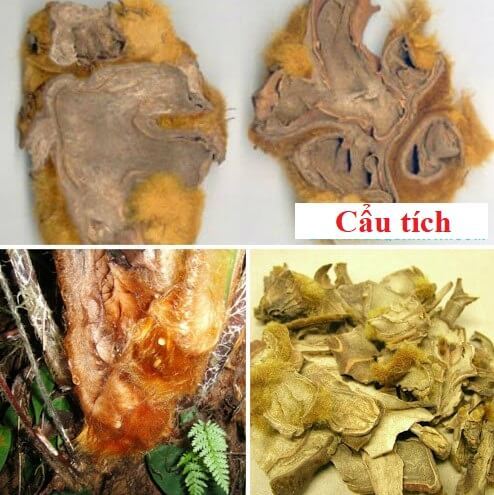
Hình ảnh dược liệu cẩu tích
Bảo quản
Dược liệu sau khi chế biến được bảo quản trong bao bì kín, để ở nơi thoáng mát và tránh ẩm mốc.
1.5. Thành phần hóa học
Thân rễ
Theo một phân tích hóa học ở Nhật Bản cho thấy trong 100g thân rễ cẩu tích có chứa 11g pterosin, 24 mg onitin, 75 mg onitin-2'-O-β-D-glucoside và 13 mg onitin-2'- O-β-D-alloside.
Nó cũng chứa tới 8% chất béo (nhưng thường ít hơn nhiều), trong đó axit palmitic và axit linoleic là những thành phần chính.
Thân rễ chứa khoảng 30% tinh bột. Chúng là chất chống viêm, anodyne và vermifuge
Ngoài ra, phần thân rễ có chứa flavonoid và giàu các nguyên tố vi lượng như Fe, Ca, Zn, Mg, Ni, Mn, Cu, Wu,...
Bài nên xem
Tác dụng, công dụng và hướng dẫn sử dụng thuốc Trị Cốt Tán
Phần lông cu li
Các lông màu vàng trên thân rễ chứa tanin và sắc tố (chất làm se).
2. Tác dụng của cây cẩu tích
Tác dụng của cây cẩu tích được đông y và y học hiện đại công nhận tác dụng tuyệt vời của loại thảo dược này.
2.1. Theo Y học cổ truyền
Theo Đông y, vị thuốc cẩu tích có vị đắng ngọt, tính ấm và quy vào can, thận.
Công năng: Bổ can thận, mạnh gân xương, trừ phong thấp.
Công dụng:
Chữa đau khớp, đau lưng, phong thấp, tay chân nhức mỏi, bệnh thấp khớp, đau dây thần kinh tọa, thoái hóa cột sống, thoái hóa khớp, người già thận yếu đi tiểu nhiều, bệnh trĩ.
Lông Cu li được sử dụng đúng cách sẽ rất hữu ích để ngăn xuất huyết từ các mao mạch.
2.2. Theo y học hiện đại

Cây cẩu tích chữa bệnh xương khớp
Theo một nghiên cứu đã phân lập được từ thân rễ bao gồm cibotiumbaroside B và cibotiglycerol cho thấy ức chế sự hình thành tế bào hủy xương mà không ảnh hưởng đến đại thực bào có nguồn gốc từ tủy xương.
Chiết xuất n-butanol từ cây cẩu tích có ảnh hưởng đến sự tăng sinh tế bào của nguyên bào xương ở chuột.
Nghiên cứu khác chỉ ra rằng chiết xuất từ cây cẩu tích có thể là một loại thuốc thay thế tiềm năng để phòng ngừa và điều trị chứng loãng xương sau mãn kinh.
Các lát thân rễ của C. barometz được hấp với rượu gạo và các thành phần chỉ số của nó như axit protocatechuic và aldehyde protocatechuic được phát hiện để thúc đẩy sự tăng sinh và biệt hóa của nguyên bào xương chuột chính được nuôi cấy trong ống nghiệm
Hoạt động chống ung thư: ức chế sự gia tăng của các tế bào ung thư tuyến tiền liệt LNCaP và PC-3.
Hoạt động bảo vệ gan: Onychin thể hiện tác dụng chống oxy hóa và bảo vệ gan khỏi tổn thương gan do lipid peroxide gây ra ở chuột. Nó làm giảm đáng kể mức độ lipid peroxide malondialdehyde trong đồng nhất của gan.
#QUANG_CAO_TIN_LIEN_QUAN
2.3. Cách dùng và liều dùng cây cẩu tích
Liều dùng: 10 - 18g mỗi ngày.
Cách dùng: Dạng thuốc sắc, ngâm rượu hoặc chế dưới dạng cao cẩu tích.

3. Bài thuốc chữa bệnh từ cây cổ tích
Dưới đây là một số bài thuốc sử dụng cây cẩu tích giúp mạnh gân cốt, bổ can thận, cụ thể:
3.1. Bài thuốc trị phong tê thấp, chân tay tê bại
Dược liệu: Cẩu tích 20g; mộc qua, tần giao mỗi vị 12g; đỗ trọng, tục đoạn, tang chi, ngưu tất mỗi vị 8g; tùng tiết, quế chi mỗi vị 4g.
Thực hiện: Sắc các dược liệu trên với 1 lít nước đến khi cạn còn 200 - 250ml, chia 2 lần uống trong ngày.
3.2. Chữa phong thấp, đau nhức xương khớp
Dược liệu: Cẩu tích 15g; bổ cốt toái và tục đoạn mỗi vị 12g; đương quy 10g; bạch chỉ và xuyên khung mỗi vị 4g.
Thực hiện: Đêm các dược liệu trên sắc nước uống. Mỗi ngày dùng 1 thang.

Cây cẩu tích chữa phong thấp
3.3. Viêm cột sống tăng sinh có gai do can thận bất túc
Dược liệu: Cẩu tích, bạch thược, thục địa, nhục thung dung, ngưu tất, cốt toái bổ mỗi vị 15g; sơn thù du, câu kỳ tử, nữ trinh tử, đư��ng quy mỗi vị 10g; kê huyết đằng 30g, mộc hương 6g.
Thực hiện: Sắc các dược liệu với nước. Mỗi ngày dùng một thang.
3.4. Các khớp tê buốt, sung phát cước khi thời tiết lạnh
Dược liệu: Cẩu tích, bạch chỉ, cốt toái, thiên niên kiện, độc hoạt, thương truật mỗi vị 15g; bạch truật 20g; xuyên khung, tô mộc, tùng hương hay nhũ hương, quế chi mỗi vị 10g; phụ tử chế, cam thảo mỗi vị 8g.
Thực hiện: Sắc các dược liệu trên với nước.
Lưu ý: Bài thuốc này chỉ nên dùng cách ngày, có nghĩa là sắc uống 2 ngày dùng một thang.
3.5. Trị đau nhức cột sống

Cây cẩu tích trị đau nhức cột sống
Dược liệu: 15g cẩu tích, thổ ti tử, lộc giao, sơn thù du, ngưu tất, đỗ trọng mỗi vị dược liệu dùng 11g, cùng với 15g thục địa.
Thực hiện: Đem tất cả dược liệu cho vào nồi nước sắc trong vòng 20 phút. Chia làm 3 lần uống trong ngày.
3.6. Đau nhức ngang lưng, đau dây thần kinh liên sườn
Dược liệu: Cẩu tích 15g, sinh mễ nhân 12g, ngưu tất và đỗ trọng 10g, mộc qua 6g.
Thực hiện: Sắc các dược liệu trên với 600ml đến khi cô cạn còn 200ml. Chia 3 lần uống trong ngày.
3.7. Đau nhức xương, bại liệt co quắp
Dược liệu: cẩu tích 15g, tục đoạn 12g, bổ cốt toái 12g, bạch chỉ 4g, đương quy 10g, xuyên khung 4g.
Thực hiện: Sắc các vị thuốc trên với 500ml, đun đến khi cô cạn còn 250ml thì gạn lấy phần nước và dùng trong ngày.
Bài nên xem
Thuốc Đông y Trị Cốt Tán – Khắc tinh của bệnh xương khớp
3.8. Đau nhức các khớp
Dược liệu:
Cẩu tích 30g, cốt toái, huyết giác, độc hoạt, ngưu tất mỗi thứ 20g; sinh địa, mạch môn, mộc qua, đan bì, cốt khí củ mỗi thứ 15g.
Nếu đau lưng, nhức mỏi, gia thêm ba kích, tục đoạn, hà thủ ô mỗi thứ 12g.
Chân tê bì hay hơi nề, gia mộc thông, tỳ giải, thiên niên kiện mỗi thứ 12g.
Sưng khớp có sốt, gia hoàng đằng 12g, bạch chỉ 6g.
Thực hiện: Sắc các dược liệu trên với nước. Mỗi ngày một thang.
3.9. Bài thuốc chữa chứng viêm khớp và phong tê thấp
Dược liệu: Cẩu tích, cốt toái bổ, tỳ giải, cỏ xước, thổ phục linh, rễ uy linh tiên nam và thiên niên kiện mỗi vị 10 - 15g.
Thực hiện: Đem các vị thuốc trên sắc lấy nước uống.
3.10. Bài thuốc trị đau xương khớp ở người cao tuổi

Cẩu tích chữa đau nhức xương khớp ở người già
Dược liệu: Cẩu tích, tục đoạn, hà thủ ô đỏ, cốt toái bổ, đơn bì huyết giác, ba kích, mộc qua, ngưu tất, sinh địa mỗi vị 12g; cam thảo 8g.
Thực hiện: Sắc các dược liệu trên với nước, uống hàng ngày.
3.11. Bài thuốc trị chứng đau thần kinh tọa, phong trúng vào kinh thận
Dược liệu: Cẩu tích, tỳ giải, đỗ trọng, bạch linh mỗi vị 40g; hà thủ ô đỏ, thiên hùng và trạch tả mỗi vị 20g.
Thực hiện: Đem các vị thuốc trên tán thành bột mịn, mỗi lần dùng 8g và uống với nước cơm.
3.12. Bổ thận khỏe lưng
Dược liệu: Cẩu tích 16g, ngưu tất 12g, thỏ ty tử 12g, sơn thù du 12g, đỗ trọng 12g, thục địa 16g, cao ban long 12g. Cao ban long để riêng.
Thực hiện: Sắc các vị khác lấy nước rồi hòa cao ban long vào để uống.

Cây cẩu tích chữa các bệnh về thận
3.13. Chữa thận hư, đau lưng
Dược liệu: Cẩu tích 15g, thục địa 12g, đỗ trọng 10g, dây tơ hồng 8g, kim anh tử 8g.
Thực hiện: Sắc uống trong ngày.
3.14. Trị đau lưng, mỏi gối, thận âm hư
Dược liệu: Cẩu tích, thỏ ty tử, đương quy, phục linh, lượng bằng nhau.
Thực hiện: Nghiền thành bột, luyện mật ong thành viên 9g. Ngày uống 3 lần. Mỗi lần 1 - 2 viên uống với nước sôi.
3.15. Đau mỏi thắt lưng, phụ nữ đới hạ
Cẩu tích và thục địa mỗi vị 16g; ngưu tất, thỏ ty tử, sơn thù du, lộc giao (nhung hươu), đỗ trọng mỗi thứ 16g. Sắc uống.
Bài nên xem
Sử dụng Trị Cốt Tán như thế nào để đạt hiệu quả điều trị cao nhất
3.16. Lưng gối mỏi do thận can hư
Cẩu tích 10g, sa uyển tử 12 - 15g, đỗ trọng 10 - 12g. Sắc uống ngày 1 thang.
3.17. Điều trị chứng thận hư, tiểu đêm, di mộng tinh
Dược liệu: Cẩu tích 20g, Thục địa 15g, Đỗ Trọng dây 15g, dây tơ hồng 15g, Kim anh 15g.
Thực hiện: Sắc các vị thuốc trên với 500ml nước, sắc cạn còn khoảng 200ml nước. Chia 2 lần uống trong ngày. Duy trì thực hiện đến khi thấy triệu chứng thuyên giảm
3.18. Chữa chứng đau mỏi mắt

Cẩu tích chữa chứng đau mỏi mắt
Dược liệu: Cẩu tích 15g, Thỏ Ty Tử, Sơn thù Du, Ngưu tất, Lộc Giao, Đỗ trọng mỗi loại dược liệu dùng 13g, thục địa17g.
Thực hiện: Sắc các dược liệu trên cùng với 50ml nước lọc. Chia thành 2 lần thuốc uống trong ngày. Duy trì liên tục 3 ngày sẽ khỏi.
3.19. Bài thuốc trị cao huyết áp, xơ cứng mạch và tai biến mạch máu não
Chuẩn bị: Linh chi, hoàng tinh, đỗ trọng, kê huyết đằng, thỏ ty tử, cẩu tích, thạch xương bồ và đơn bì, gia giảm liều lượng theo tình trạng bệnh.
Thực hiện: Sắc uống.
3.20. Bài thuốc trị chứng bại liệt ở trẻ nhỏ
Chuẩn bị: Cương tàm 60g, thỏ ty tử 60g, mã tiền tử (sao cát), mộc qua, ngưu tất, ô xà nhục, xuyên tỳ giải, ngô công, đương quy, tục đoạn, dâm dương hoắc (chích), cẩu tích, nhục thung dung và mai mực mỗi vị 30g.
Thực hiện: Cho các dược liệu tán thành bột mịn. Sau đó đem dâm dương hoắc sắc lấy nước, sau đó hòa với thuốc bột làm thành viên. Mỗi lần dùng từ 0.3 – 1g uống với nước sôi ấm, ngày dùng 3 lần. Nếu cơ thể yếu nên gia giảm liều lượng.
>> Xem thêm: Rau dền gai - Vị thuốc quý trị bệnh cứu người
5. Một số lưu ý khi sử dụng cây cây cẩu tích để đạt tác dụng tốt nhất
Bất kỳ dược liệu nào có dược tính đều có thể gây tác dụng không mong muốn cho cơ thể, đo đó, người bệnh cần lưu ý những điều sau đây khi sử dụng:
Không dùng cho người thận bị hư nhiệt, nước tiểu vàng.
Phụ nữ có thai và cho con bú không nên sử dụng
Không dùng kết hợp Cẩu tích với Sa thảo và Tỳ giải.
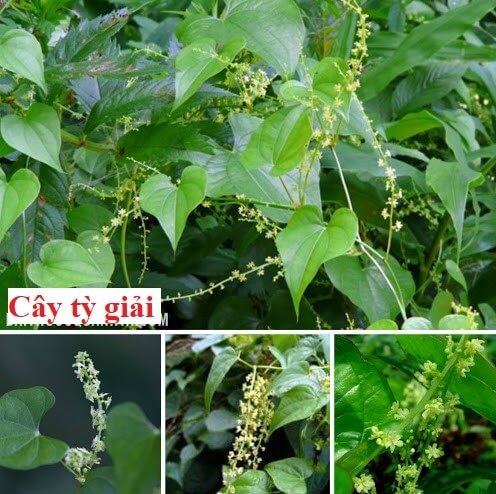
Không dùng cẩu tích kết hợp với tỳ giải
Trên đây là những thông tin về cây cẩu tích mà bạn có thể tham khảo được. Tốt nhất trước khi sử dụng bạn nên tham khảo ý kiến của thầy thuốc để tránh gặp sai lầm khi sử dụng.
Bạn còn băn khoăn về tình trạng bệnh của mình, đặc biệt là bệnh lý cơ xương khớp thì TRỊ CỐT TÁN là một giải pháp tối ưu cho bạn.
Bài thuốc Đông y gia truyền TRỊ CỐT TÁN với sự kết hợp giữa bài thuốc chườm và thuốc đắp làm thuyên giảm tình trạng bệnh lý cơ xương khớp.
Nếu bạn còn thắc mắc về bệnh lý cơ xương khớp và sản phẩm Trị Cốt Tán, hãy liên hệ hotline dưới đây để được tư vấn miễn phí.
0961 666 383
Đừng ngần ngại like và để lại bình bình luận, cũng như chia sẻ bài viết đến những người xung quanh. Mong nhận được phản hồi từ quý bạn đọc. Cảm ơn bạn nhiều!
Click vào link để xem bài viết gốc: https://tricottan.com.vn/cau-tich
0 notes
Photo

#Tinynktober 1. Carnotaurus 2. Dicksoniaceae 3. Nelumbonaceae (J'ai 1 mois pour m'améliorer sur les végétaux) #dinoctober #hellotritrichoupi #dinoctober2020 https://www.instagram.com/p/CFz55A5DFry/?igshid=1flnu5xjwsgx9
0 notes
Text
Cẩu tích: Cây lông cu ly bổ Can Thận
Cẩu tích còn có tên khác là Lông cu ly, Cù liền, Lông khỉ, Kim mao; tên khoa học của Cẩu tích là Cibotium barometz (L.) J. Sm. thuộc họ Lông cu ly (Dicksoniaceae). Từ lâu Cẩu tích được dùng với công dụng: ngâm rượu hoặc sắc uống chữa đau lưng, nhức xương khớp, lông...
The post Cẩu tích: Cây lông cu ly bổ Can Thận appeared first on YouMed.
from WordPress https://bit.ly/2XUddjr
via IFTTT
0 notes
Text
#941 - Dicksonia antarctica - Soft Tree Fern

I forgot to mention some of the plants I saw on the trip up to the Snowys - this large tree fern, for example.
Also known as the man fern, Australian tree fern, Tasmanian tree fern, hardy tree fern, and woolly tree fern, this is one of Australia’s most common tree ferns, growing up to 15 meters high and 6 wide. If I’m right on the ID, finding this high up in the Snowys is a little odd, since some of the sources I was consulting say it prefers damp gullies, and altitudes below 1000m. On the other hand, it was on the shady southern side of the ridge, and it is known to be cold-tolerant. Often grown and exported as an ornamental, although it’s so slow-growing that nearly all specimens are collected from the wild, and often from areas about to be clear-felled for timber. They do not recover well from disturbance, which is a problem given how important they are to other species.
Alpine Way, near Thredbo, in the Snowy Mountains
5 notes
·
View notes